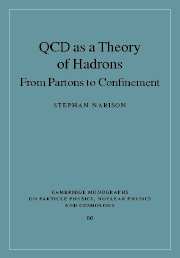Book contents
- Frontmatter
- Contents
- About Stephan Narison
- Outline of the book
- Preface
- Acknowledgements
- Part I General introduction
- Part II QCD gauge theory
- Part III MS-bar scheme for QCD and QED
- Part IV Deep inelastic scatterings at hadron colliders
- Part V Hard processes in e+e– collisions
- Part VI Summary of QCD tests and αs measurements
- Part VII Power corrections in QCD
- 26 Introduction
- 27 The SVZ expansion
- 28 Technologies for evaluating Wilson coefficients
- 29 Renormalons
- 30 Beyond the SVZ expansion
- Part VIII QCD two-point functions
- Part IX QCD non-perturbative methods
- Part X QCD spectral sum rules
- Part XI Appendices
- Bibliography
- Index
29 - Renormalons
from Part VII - Power corrections in QCD
- Frontmatter
- Contents
- About Stephan Narison
- Outline of the book
- Preface
- Acknowledgements
- Part I General introduction
- Part II QCD gauge theory
- Part III MS-bar scheme for QCD and QED
- Part IV Deep inelastic scatterings at hadron colliders
- Part V Hard processes in e+e– collisions
- Part VI Summary of QCD tests and αs measurements
- Part VII Power corrections in QCD
- 26 Introduction
- 27 The SVZ expansion
- 28 Technologies for evaluating Wilson coefficients
- 29 Renormalons
- 30 Beyond the SVZ expansion
- Part VIII QCD two-point functions
- Part IX QCD non-perturbative methods
- Part X QCD spectral sum rules
- Part XI Appendices
- Bibliography
- Index
Summary
Introduction
The renormalon problem is related to the well-known fact [372,375] (for more complete reviews, see for example [162,154]) that the QCD series is unfortunately divergent (no finite radius of convergence) like n!, which is the number of diagrams of nth order. Indeed, a given observable can be expressed as a power series of the coupling g as:
where the series are divergent:
and where the nth order grows like n!, such that it is not practicable to have a quantitative meaning of Eq. (29.1). For the approximation to be meaningful, the approximation should asymptotically approach the exact result in the complex g-plane, such that:
where the truncation error at order N should be bounded to the order gN+1. If fn behaves like in Eq. (29.2), KN usually behaves as aN N!Nb. The truncation error behaves similarly as the terms of the series. It first decreases until:
beyond which the approximation to F does not improve through the inclusion of higherorder terms. For N0 ≫ 1, the approximation is good up to terms of the order:
Provided fn ∼ Kn, the best approximation is reached when the series is truncated at its minimal term and the truncation error is given by the minimal term of the series.
- Type
- Chapter
- Information
- QCD as a Theory of HadronsFrom Partons to Confinement, pp. 315 - 328Publisher: Cambridge University PressPrint publication year: 2004



